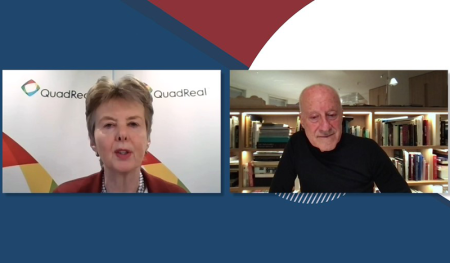Speaking at the 2021 ULI Virtual Europe Conference in February, leading architect Norman Foster said that he remains optimistic about the future of cities as centers of civilization, saying, “The story of cities is really the story of crises. Throughout history, cities have bounced back better after a crisis.”
His award-winning architectural design and engineering firm, Foster + Partners, is known for its innovative, modern, and sustainable approach.
Lord Foster was interviewed by Rosemary Feenan of QuadReal Property Group. She said that he has “a consciousness and concern for the sustainability and resilience of our urban futures that goes way beyond simply the structure.”
Foster said that the 17th-century fire of London heralded much of the safety precautions that are common today, also creating the “DNA of London as we take it for granted today” with Georgian squares and terraces. He also said that the 18th-century earthquake that devastated Lisbon informed much of the thinking on seismic proofing buildings during the years that followed.
Foster said that the 19th-century cholera pandemic led to the embankment of the Thames River and more modern sanitation. New York City similarly saw its population decrease due to cholera, and Central Park was created to provide open space and improve air quality.
“With all these examples, I would suggest what seems like change in the wake of a pandemic, is really accelerating trends that were already there,” he said.
“Technology has always been there at any point in time. Technology has always been the spur to innovation,” said Foster. He cited cathedrals as something that would be difficult to duplicate with modern building techniques. “Changing patterns of work is not new. It has been said that if you want to look far into the future, first look far back into the past.”
Foster said that the shifts in mobility mean less space is required for certain kinds of transport, since the next generation is not as interested as previous generations in private ownership of cars or bicycles, accessing them only as an on-demand service. He said, “This opens the prospect of rediscovering a tradition of the past of greening of the city, of noble avenues, with more space for trees which consume carbon dioxide, making the city greeener, quieter, and safer.”
Foster says he hopes that cities will become more attractive, more desirable, without the pollution, and rediscovering the sense of place that transcends individual buildings. He said, “That’s not in any way to denigrate the importance of an important building which is a celebration. But, in a way, the greater celebration is the background buildings that don’t shout at you; [buildings] that create very desirable outdoor rooms and outdoor spaces. That’s the essence of urbanity.”
You can still register for the 2021 ULI Virtual Europe Conference.






